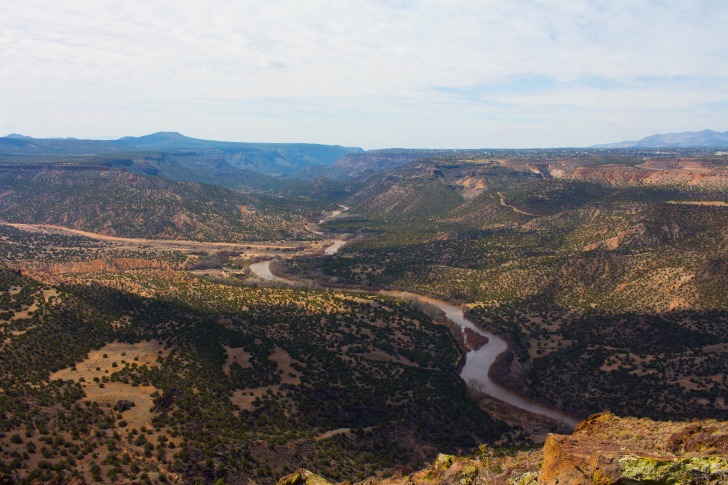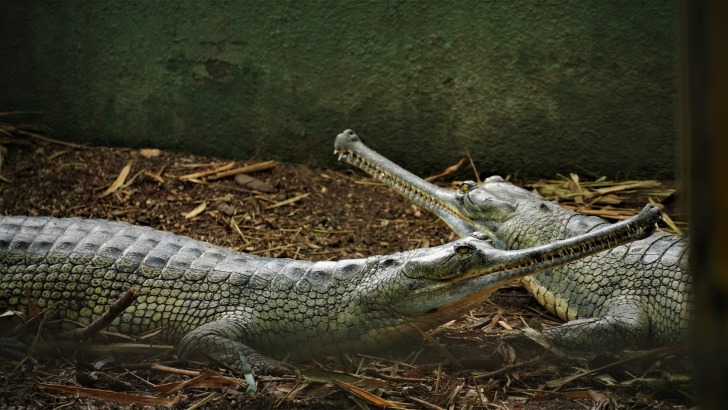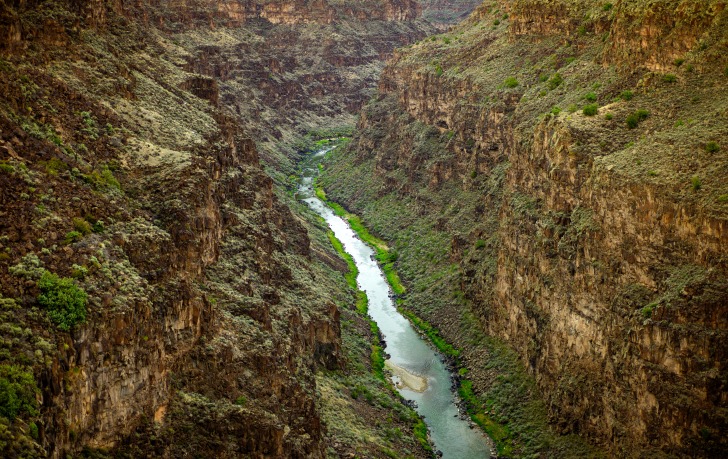The Rio Grande starts in Colorado and flows 460 miles before it gets to the Mexican border at El Paso.
From there, the Rio Grande separates Texas and Mexico for 1420 more miles to the Gulf coast.
It starts out in the mountains of Colorado, but most of the river is in the desert areas of the Mexican border.
In those 1800 miles, there is a tremendous variety of wildlife.

Contents
So… Are There Alligators in the Rio Grande?
There are plenty of alligators at the Las Palomas Wildlife Area where the Rio Grande empties into the gulf coast.
Alligators like coastal areas with warm fresh water, so the river there is a great habitat.
As you go inland along the Rio Grande, the alligators get fewer in number.
There have been a few reported at the Falcon Lake Reservoir, about 80 miles from the coast where a dam on the Rio Grande created the lake.
There is also Alligator Gar in that lake, which is confused with alligators at times.
Historically, alligators have lived as far inland as Laredo, about 40 miles up the Rio Grande from Falcon Lake.
There are some alligators in the coastal areas where the Rio Grande enters the gulf of Mexico.
They gradually become rarer the further inland you go along the Rio Grande.
Alligator Species in the Rio Grande
Any alligator in the Rio Grande is going to be an American Alligator.
There are only two species of alligator.
One of them lives in the southeast United States and the other lives in China.
The alligators are part of the crocodilian family, and there are several species of crocodiles around the world.
Alligators can be found along the Rio Grande near the coast and they get fewer in number the further you go up the river from the coast.
There is a species called the American Crocodile and there are not many of them.
Most of them live on the southern tip of Florida, but there is an occasional report of a sighting along the RioGrande.
There have been reports of crocodiles in the river at times, but they might be alligators.
Is it Safe to Swim in the Rio Grande?
The closer you are to the coast, the more chance you have of running into an alligator.
Along the 1800 miles of the river, there are several reservoirs that have been created over the years.
All of these reservoirs have beaches and swimming areas that are safe.
It is generally safe to swim in the reservoirs along the Rio Grande.
The river itself has some safe swimming areas too.
In most places, the river is not all that wide and can almost be walked across.
As you get further inland there will be no alligators, but there are other dangers.
Rattlesnakes and other poisonous creatures like to live along the river because there is no water for many miles in either direction.
If you stick to marked swimming areas that have been cleared for that purpose, you will probably find it safe.
Swimming in remote areas that are wild is more dangerous because of snakes.
The water levels can also change quickly and there can be dangerous currents in the river.
The water is also not clear and there could be objects below the water’s surface that could cause an injury.
Another danger is bacteria levels, and many of those are caused by natural causes.
The levels go up and down fast, and the water may or may not be safe for that reason.
You probably also do not have the equipment to measure the bacteria levels.
Interesting Alligator Facts in Rio Grande
The Mexican news media is reporting that United States border agents are dumping alligators into the Rio Grande, and even some crocodiles to discourage immigrants from crossing the border illegally.
The news report cited the Texas Ranch Association, but there appears to be no such organization in Texas.
There are alligators near the coast where some immigrants try to get across the border illegally.
Early in 2022, the Snopes fact-checking website debunked the claim that Louisiana sent 2000 alligators to Texas to be put in the river to deter immigrants.
There have been several immigrants killed near the coastal areas while they were trying to cross the river, but it has not been confirmed that they were alligators, or that they were put there by border agents.
Alligators were nearly extinct in the late 1960s.
They lived much further inland along the Rio Grande until then.
They were put on the endangered species list in 1973, and have made a comeback with hunting restrictions and conservation measures.
They were taken off the list in Texas in 1989, and there are a lot of them in Texas now.
They are still inland to some degree on the Rio Grande, but not as far as they were at one time.
The southern tip of Florida is the only known place where both alligators and crocodiles live naturally.
There have been some unconfirmed reports of crocodiles near the coastal part of the Rio Grande.
Some call them American crocodiles, but they may really just be alligators.
The largest alligator found in Texas was killed in 2013 at the Choke Canyon Reservoir.
The alligator weighed 800 pounds and was 14 feet long.
Choke Canyon is about 100 miles north of the Rio Grande and is the furthest west alligators can be found.
In this area, only a few permits for alligator hunting are issued each year.
Alligators store fat in their tails, which allows them to go a long time without eating.
They may eat only once or twice per week and can go as long as a year without eating.
Alligators enter a brumation state, which is like hibernation when it gets too cold.
Their body slows down, they do not eat, and they move very little until the water warms up.
As long as the water does not completely freeze it can stay in that state for a very long time.

Alligators vs. Crocodiles
Appearance: Alligators are gray to black, with a creme-colored underbelly.
Crocodiles are tan or olive green, and also have a lighter underside.
They both have thick skin that is wanted for the strong leather it can produce.
Head: Alligators have a broader, more u-shaped snout, while crocodiles have a more pointed, or v-shaped snout.
Crocodiles’ teeth are still visible when their mouth is closed, but that is not the case for alligators.
Crocodiles have about 100 teeth, while alligators have around 80.
Both can regrow teeth that are lost or worn down, and they may go through thousands over their lifetime.
Strength and speed. Crocodiles have a bite that measures 3700 pounds per square inch, which is the strongest bite of any creature on Earth.
Crocodiles are also among the strongest at 2500 PSI.
Humans bite between 120 and 600 psi.
While both have a strong bite, they do not have strong muscles for opening their mouths.
As a result, a single person can hold their mouth shut.
Speed. Alligators can go 30 miles per hour and a crocodile can hit 20 miles per hour, but both can only do that for a short distance.
Alligators have webbed feet, which allow them to swim faster than crocodiles as well.
Longevity. Alligators can live up to 50 years, and crocodiles have been known to live 70 years.
Habitat. Both like living in coastal areas.
Crocodiles like salt water, but alligators are not able to tolerate salt water.
Alligators live only in the southeast United States, and in China.
Crocodiles live in equatorial zones around the world.
Size. Alligators average 1000 pounds and are 10 feet long.
They can get larger if they live long enough.
Crocodiles are much larger, weighing up to 2000 pounds, and can be 20 feet long.
3 Safety Tips for Swiming in Alligator-infested Waters
- Stay 50 feet away. If you are swimming near the gulf of Mexico, you can see some alligators. When they are lying in the sun on a river or lake bank, they are relatively harmless. It is a good idea to stay 50 feet away because they are very fast over a short distance. If you see one coming toward you, you need to get out of the way. Be very careful if you see young alligators. The mother gator is not far away and will be very aggressive in defending the young.
- Don’t swim at night, or alone. Alligators like to lie in the sun and sleep all day. They look for food at night. Other animals look for food at night too. You cannot see into the water at night, and there could be things in there that could cause injury. It is not a good idea to swim alone, even in the daytime, because you never know when you will get in trouble. If something happens, you will need someone there to help.
- Don’t feel alligators. Feeding alligators can make them aggressive. It also makes them associate people with food, and they will become bolder in approaching people for food. It is also not healthy for them. Don’t clean your fish and leave the scraps behind, or in the water. That is also feeding alligators indirectly. It is not a good idea to feed any wild animal for the same reason it is not a good idea to feed alligators.
Summary
The Rio Grande is an 1800-mile-long river, from the mountains of Colorado to the Gulf of Mexico.
Near the gulf coast, there are some alligators, and they get scarcer the further you go inland.
Frequently Asked Questions
How many people have been killed or injured by alligators in Texas?
There has been only one reported death from an alligator attack since 1836, nearly 185 years ago.
That one happened in 2015 when a man fell into a marina in Orange, Texas, which is more than 100 miles from the Rio Grande.
In the last couple of years, there have been people found dead trying to get across the border, and alligators are suspected, but not confirmed.
When is hunting season?
In core counties, where most alligators live, there is a hunting season in September.
In other counties, there is a spring season from April until June.
You must have a hunting license, but there is no specific license for alligators.
You may take one alligator per year if you have a hunting license.
Can you own an alligator in Texas?
The only people who can legally own alligators in Texas are permitted alligator farmers and zoos.
It is also illegal to release an alligator into the wild.
How common are alligators in Texas?
There are an estimated 500,000 alligators in the state, and they are in about a third of the counties in Texas.
Orange, Jefferson, and Chambers counties are estimated to have 300,000, and none of those counties are near the Rio Grande.
There are some near where the Rio Grande enters the Gulf of Mexico, and while they are relatively common, they are not there in great numbers.












It is generally safe to swim in the reservoirs along the Rio Grande, but there are other dangers such as snakes and bacteria levels that can change quickly.
Alligators have made a comeback since being on the endangered species list in 1973. They can live up to 50 years and grow up to 10 feet long for alligators and even larger for crocodiles. When swimming near alligator-infested waters, it’s important to stay at least 50 feet away from them, avoid swimming at night or alone, and never feed them as it makes them more aggressive towards humans.
It seems like there is a good balance between human activity and wildlife preservation along the Rio Grande river.
There are alligators in the Rio Grande near the gulf coast, but they become rarer as you go further inland.